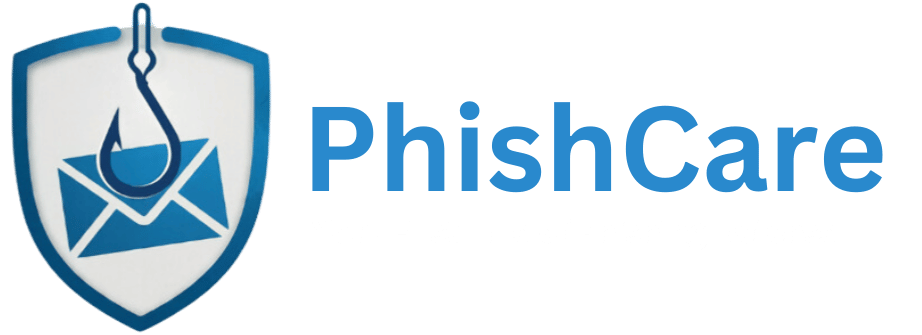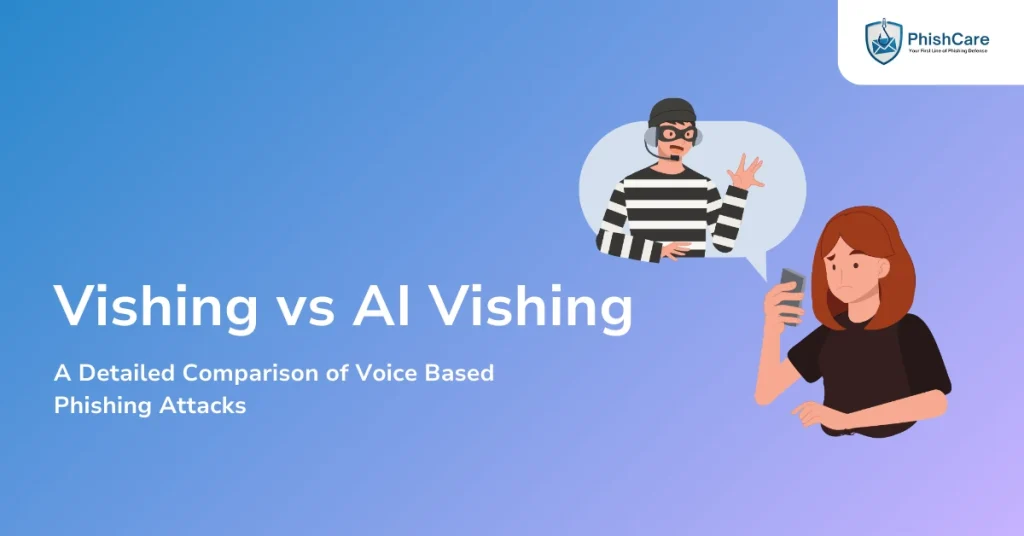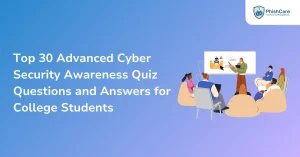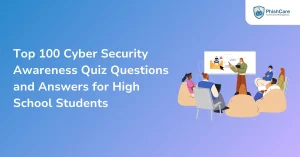Criminals have always used the phone to trick people. That’s nothing new. But the way they do it today has become way creepier.
This attack has a name called vishing, short for “voice phishing.” It used to be simple when a stranger pretended to be your bank, your boss, or even a government officer, pushing you to reveal private details. Annoying, but most of the time you could tell something felt off.
With artificial intelligence on widespread now, it has taken vishing to a whole new level. We’re now talking about AI-powered vishing where scammers clone voices, automate calls, and sound so real it’s chilling. In fact, in 2023, a UK energy firm lost $240,000 after staff were duped by a deepfake audio of their CEO ordering an urgent transfer. Sounds like a scene from a movie, right? But it happened.
And it’s not just about businesses losing money. It can also be getting a call that sounds exactly like your spouse, or your child, asking for help. That emotional pull? That’s what makes AI vishing so unnerving. With the use of AI attackers make vishing undetectable, taking impersonation to a whole new level.
What is Vishing Attack?
At its core, a vishing attack is just a scam phone call. But instead of trying to sell you something shady, the goal is to steal data like personal details, banking credentials. Even company secrets.
The word itself comes from “voice” + “phishing.” Unlike the email scams we’re used to, this happens over the phone. Criminals call their targets pretending to be someone you’d normally trust like your bank, your workplace, maybe even law enforcement. And because there’s an actual human voice on the line, it feels more convincing than just reading a suspicious email.
Victims don’t always realize they’ve been tricked until it’s too late. In 2022, the FBI reported that phone-based scams caused over $1.3 billion in losses in the U.S. alone. That’s a huge number. Further the methods vary. Sometimes it’s a fake bank employee warning about “unusual transactions.” Other times it’s a tech support agent insisting you have a virus on your laptop. The attacker pressures you to act fast or something terrible will happen. That urgency is what makes people slip.
It’s not just about dodgy calls anymore the game has shifted from “annoying spam” to high-stakes manipulation.
What is AI Vishing Attack?
If traditional vishing felt dangerous, AI-powered vishing is on a whole different level. The reason is that cybercriminals now use artificial intelligence to clone voices, generate scripts, and even automate calls. That means the “bank manager” on the phone doesn’t just sound professional, they might actually sound exactly like your real manager. This is even much scarier than the traditional method.
And this isn’t science fiction. In 2019, fraudsters used AI voice cloning to trick the CEO of a UK-based energy company into transferring $243,000. The attackers mimicked his boss’s German accent so well that the CEO didn’t think twice before sending the money. Chilling part is that the call lasted just a few minutes.
AI Vishing attacks usually work in two ways:
- Voice cloning: copying someone’s voice from a few seconds of audio (social media posts, interviews, even a WhatsApp note).
- Automated calls: using AI bots to handle multiple conversations at once, sounding smooth and human-like.
Now, this is where it gets tricky. Unlike old scams, you can’t rely on “something feels off” anymore. The fake voices are polished, the conversations flow naturally, and the emotional pressure like “transfer this now, it’s urgent” phrase feels almost impossible to question in the moment. It’s unnerving because you can’t trust the voice of someone you know.
Key Differences Between Vishing and AI Vishing
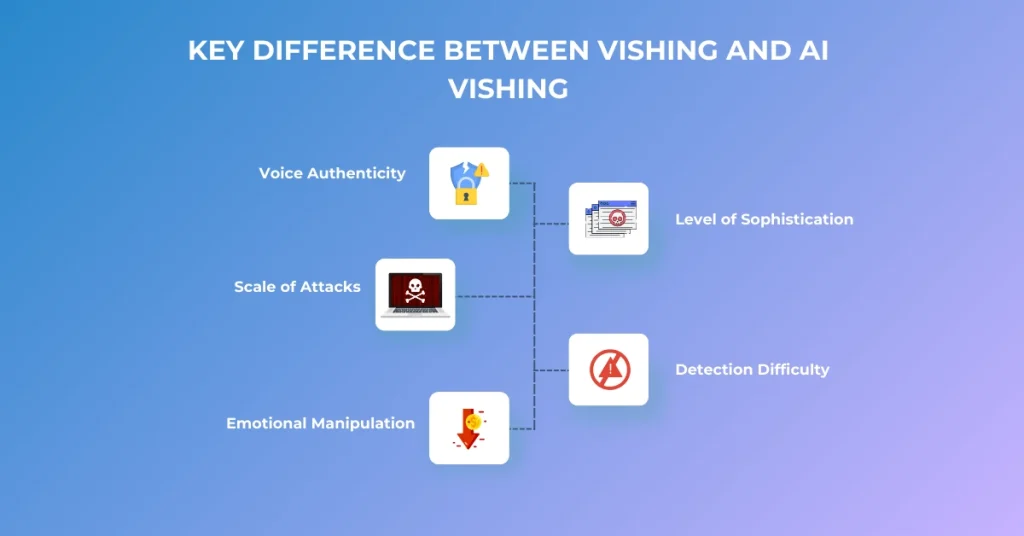
At first glance, both scams look the same. When you get a call, you hear a voice, and someone’s trying to trick you. But the biggest difference lies in how real and convincing the voice feels. Let’s break it down:
1. Voice Authenticity
Traditional vishing usually relies on a random scammer pretending to be someone else. Sometimes the accent feels off, or the tone sounds scripted. You can pick up the red flags if you listen closely. But in AI vishing? The voice can be a perfect clone. Same tone, same pauses, same laugh. It’s creepy because it doesn’t sound fake at all.
2. Scale of Attacks
With old-school vishing, scammers had to make one call at a time which quite limited their attack range. But with AI vishing the game has changed. AI bots can handle dozens or even hundreds of conversations simultaneously, each sounding natural and personalized. That scale makes it far more dangerous.
3. Emotional Manipulation
Regular vishing often uses pressure tactics with phrases like “Act now or your account will be locked!” It’s stressful, sure, but predictable. AI vishing takes it up a notch. Imagine hearing what sounds like your child’s voice crying for help, or your boss urgently telling you to wire funds. Now that’s emotional pull which is almost impossible to ignore.
4. Level of Sophistication
Old scams relied on poorly written scripts and rehearsed lies. You could sometimes sense the clumsy delivery. AI scams, on the other hand, are smooth. Natural speech patterns, realistic pauses, even background noise can be generated to make the call sound legit. It feels less like a scam and more like a real conversation.
5. Detection Difficulty
Spotting a traditional vishing attempt isn’t always hard as you notice strange grammar, awkward silences, or generic greetings. But with AI vishing, detection becomes tricky. The fake voices sound familiar, the messages feel urgent, and the confidence with which they speak lowers your guard. Victims often don’t realize it’s a scam until the damage is done.
| Aspect | Vishing | AI Vishing |
| Voice Authenticity | Human voice, often imperfect | Cloned voice, highly realistic |
| Scale of Attacks | One call at a time | Multiple calls simultaneously |
| Emotional Impact | Generic pressure tactics | Deeply personal and convincing |
| Sophistication | Scripted and clumsy | Smooth, natural, and polished |
| Detection | Easier to spot with red flags | Harder to detect, highly deceptive |
Risks of Traditional Vishing vs AI Vishing
Phone scams have always been dangerous, but AI has taken the threat to a whole new level. It’s not just about losing a few hundred dollars anymore, the stakes now include massive financial losses, emotional stress, and even corporate-level disasters. Here’s what makes the difference in risks:
1. Financial Loss
Old-school vishing usually targets individuals. Think stolen credit card details or small money transfers. Emotionally Painful? Yes. But somewhat its limited. With AI Vishing it’s a different story. Scammers can push victims into wiring millions, all because the voice sounds so real. In 2019, a UK energy company lost $243,000 after a deepfake voice of their CEO instructed an urgent transfer. One call. One mistake. Gone.
2. Emotional Manipulation
Traditional vishing leans on urgency with phrases like “Act now, or you’ll lose access!” Stressful, sure, but mostly predictable. AI vishing is far creepier. Imagine hearing what sounds like a loved one calling for help. The panic. The fear. That emotional pull is powerful and hard to shake off, even after the scam is revealed.
3. Business Impact
Traditional vishing rarely shakes entire companies; it’s mostly individuals at risk. AI vishing, though, has proven it can fool executives, bypass security protocols, and trigger large-scale fraud. One wrong call, and a business can face serious financial and reputational damage. The numbers back it up as phone-based scams caused over $1.3 billion in losses in the U.S. in 2022, and AI will only make this worse.
4. Trust Erosion
With regular vishing, people eventually learn to ignore unknown numbers. Annoying, but manageable. AI vishing throws that out the window. Now, even familiar voices can be faked. That creeping uncertainty creates a fuss like “Can I trust what I hear?” makes it unnerving. It doesn’t just cost money. It shakes confidence.
5. Scale of Threat
Traditional scams are one-to-one. Limited reach. AI scams? One-to-many. Automated bots can call hundreds of people simultaneously, all sounding convincingly real. The risk multiplies, fast and frighteningly as multiple attacks are done simultaneously.
How to Protect Yourself from Vishing and AI Vishing Attacks
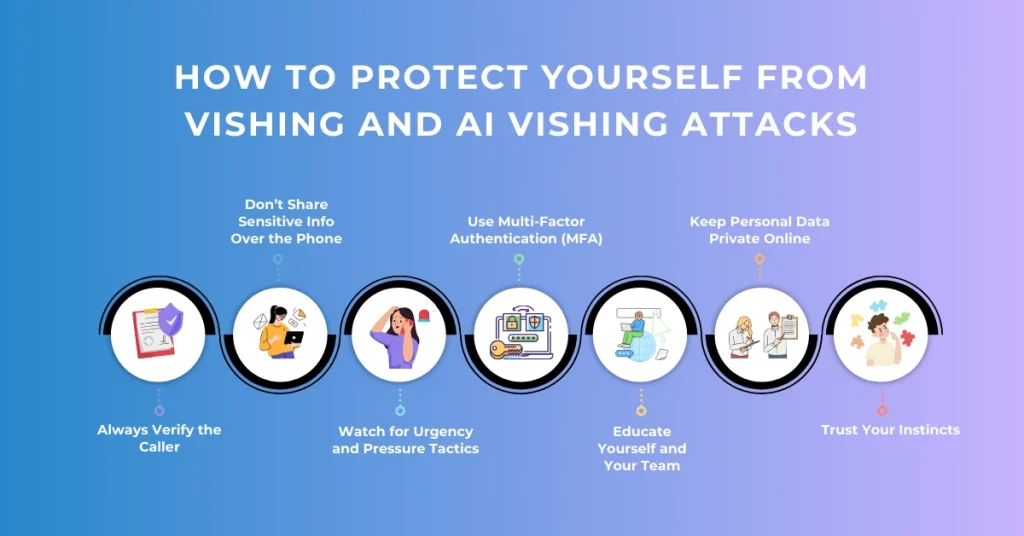
Vishing cannot be controlled and with AI vishing on the rise, it’s getting scarier by the day. But there are ways to stay one step ahead. Think of it as building your personal armor with simple steps, but they can save you from massive loss and stress.
1. Always Verify the Caller
Don’t just trust the voice on the phone. Even if it sounds like your boss, parent, or bank manager, pause. Hang up and call the official number. In 2023, a CFO almost wired $200,000 to scammers who cloned his CEO’s voice but he stopped it just in time because he double-checked. A simple verification can save a fortune.
2. Don’t Share Sensitive Info Over the Phone
Banks, government agencies, or tech support will rarely ask for passwords or full account numbers over a call. Mostly they’ll have it stored in their databases. But incase if someone does, that’s your red flag. It’s annoying to say no, but that one “stop” can prevent disaster.
3. Watch for Urgency and Pressure Tactics
“Do it now, or else!” is a classic line. It triggers panic and mistakes. Slow down. Take a breath. Scammers rely on your emotions, and AI vishing makes this even creepier with familiar voices. Pause and think as it’s your best defense.
4. Use Multi-Factor Authentication (MFA)
Even if someone tricks you into giving a password, MFA adds an extra layer of protection. One-time codes or authentication apps are the small steps which make it much harder for attackers to access your accounts.
5. Educate Yourself and Your Team
Awareness is your strongest weapon. Run simulations, join communities, share real-world stories, and keep everyone on high alert. According to recent studies, companies with proper vishing training reduce losses by over 70%. Knowledge isn’t just power, it’s money saved.
6. Keep Personal Data Private Online
Scammers often gather information from social media, LinkedIn, or even casual phone recordings. Limit what’s public. The less they know, the harder it is to clone voices or create believable scenarios.
7. Trust Your Instincts
This is totally based on human instincts. If something feels off, it probably is. AI can mimic voices perfectly, but it can’t replicate your gut feeling. Listen to it. Step back. Verify before acting. Small errors here and there and prove that there is some problem.
Conclusion
The rise of AI has changed the game. Vishing is no longer just a nuisance it’s a creepy and a sophisticated threat that can hit your wallet, your emotions, and even your business. What was once easy to spot the generic scammer on the phone is now harder to detect. Deepfake voices, automated calls, and realistic scripts make AI vishing unnervingly convincing.
But with proper instincts, awareness and caution they can be the best defenses. Pause before you act. Verify calls. Protect sensitive information. Educate yourself and your team. A few smart steps can save you from serious financial and emotional damage.
In this digital era, it’s not about fearing technology, it’s about using knowledge and vigilance to stay one step ahead. Remember this, the voice on the phone might sound real, but your instincts, verification habits, and precautions are what keep you safe. Stay alert, stay sceptical, and don’t let AI-powered scams catch you off guard.
FAQs: Vishing vs AI Vishing
1. What is the main difference between traditional vishing and AI vishing?
Answer: Traditional vishing relies on human scammers using pressure tactics over the phone. AI vishing, however, uses technology to clone voices, automate calls, and make scams far more convincing and harder to detect.
2. Can AI vishing target businesses as well as individuals?
Answer: Yes. AI vishing can target executives and employees, bypass company security protocols, and cause large-scale financial or reputational damage, making it a serious corporate threat.
3. How can I protect myself from vishing and AI vishing?
Answer: Always verify the caller, avoid sharing sensitive information over the phone, watch for urgent pressure tactics, use multi-factor authentication, and educate yourself or your team about common scams.
4. Are AI vishing attacks detectable?
Answer: They are much harder to detect than traditional scams. The voices sound realistic, and scripts flow naturally. Trusting your instincts, verifying calls, and implementing security measures are key to spotting them.
5. How common are vishing and AI vishing attacks?
Answer: Phone-based scams caused over $1.3 billion in losses in the U.S. in 2022, and with AI tools becoming more accessible, experts warn these attacks are increasing rapidly both for individuals and businesses.
